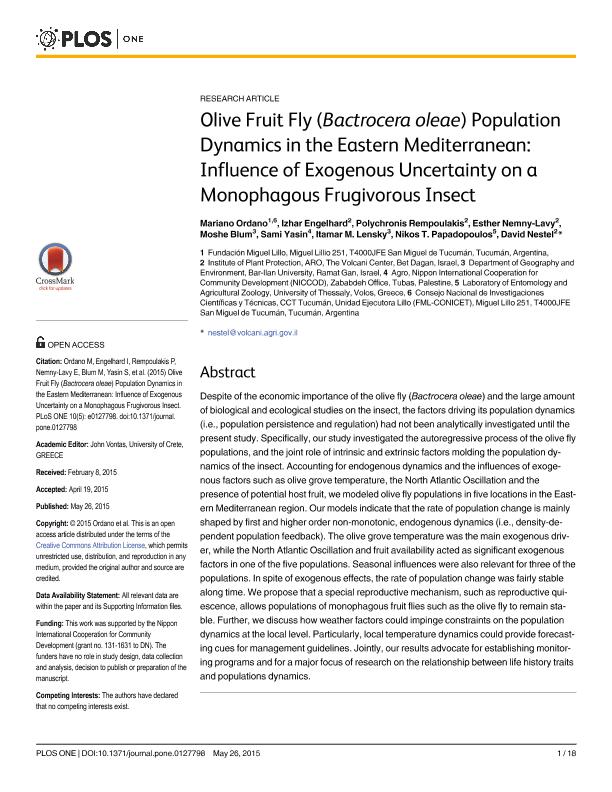Mostrar el registro sencillo del ítem
dc.contributor.author
Ordano, Mariano Andrés

dc.contributor.author
Engelhard, Izhar
dc.contributor.author
Rempoulakis, Polychronis
dc.contributor.author
Nemny Lavy, Esther
dc.contributor.author
Blum, Moshe
dc.contributor.author
Yasin, Sami
dc.contributor.author
Lensky, Itamar M.
dc.contributor.author
Papadopoulos, Nikos T.
dc.contributor.author
Nestel, David
dc.date.available
2017-02-07T21:40:12Z
dc.date.issued
2015-05
dc.identifier.citation
Ordano, Mariano Andrés; Engelhard, Izhar; Rempoulakis, Polychronis; Nemny Lavy, Esther; Blum, Moshe; et al.; Olive fruit fly (Bactrocera oleae) population dynamics in the Eastern Mediterranean: influence of exogenous uncertainty on a Monophagous Frugivorous insect; Public Library Of Science; Plos One; 10; 5; 5-2015; 1-18; e0127798
dc.identifier.issn
1932-6203
dc.identifier.uri
http://hdl.handle.net/11336/12710
dc.description.abstract
Despite of the economic importance of the olive fly (Bactrocera oleae) and the large amount of biological and ecological studies on the insect, the factors driving its population dynamics (i.e., population persistence and regulation) had not been analytically investigated until the present study. Specifically, our study investigated the autoregressive process of the olive fly populations, and the joint role of intrinsic and extrinsic factors molding the population dynamics of the insect. Accounting for endogenous dynamics and the influences of exogenous factors such as olive grove temperature, the North Atlantic Oscillation and the presence of potential host fruit, we modeled olive fly populations in five locations in the Eastern Mediterranean region. Our models indicate that the rate of population change is mainly shaped by first and higher order non-monotonic, endogenous dynamics (i.e., density-dependent population feedback). The olive grove temperature was the main exogenous driver, while the North Atlantic Oscillation and fruit availability acted as significant exogenous factors in one of the five populations. Seasonal influences were also relevant for three of the populations. In spite of exogenous effects, the rate of population change was fairly stable along time. We propose that a special reproductive mechanism, such as reproductive quiescence, allows populations of monophagous fruit flies such as the olive fly to remain stable. Further, we discuss how weather factors could impinge constraints on the population dynamics at the local level. Particularly, local temperature dynamics could provide forecasting cues for management guidelines. Jointly, our results advocate for establishing monitoring programs and for a major focus of research on the relationship between life history traits and populations dynamics.
dc.format
application/pdf
dc.language.iso
eng
dc.publisher
Public Library Of Science

dc.rights
info:eu-repo/semantics/openAccess
dc.rights.uri
https://creativecommons.org/licenses/by-nc-sa/2.5/ar/
dc.subject
Population Ecology
dc.subject
Population Dynamics
dc.subject
Agroecology
dc.subject
Integrated Pest Management
dc.subject
Climate Effects
dc.subject.classification
Ecología

dc.subject.classification
Ciencias Biológicas

dc.subject.classification
CIENCIAS NATURALES Y EXACTAS

dc.subject.classification
Otras Ciencias Agrícolas

dc.subject.classification
Otras Ciencias Agrícolas

dc.subject.classification
CIENCIAS AGRÍCOLAS

dc.title
Olive fruit fly (Bactrocera oleae) population dynamics in the Eastern Mediterranean: influence of exogenous uncertainty on a Monophagous Frugivorous insect
dc.type
info:eu-repo/semantics/article
dc.type
info:ar-repo/semantics/artículo
dc.type
info:eu-repo/semantics/publishedVersion
dc.date.updated
2017-02-07T17:50:37Z
dc.journal.volume
10
dc.journal.number
5
dc.journal.pagination
1-18; e0127798
dc.journal.pais
Estados Unidos

dc.journal.ciudad
San Francisco
dc.description.fil
Fil: Ordano, Mariano Andrés. Fundación Miguel Lillo; Argentina. Consejo Nacional de Investigaciones Científico y Técnicas. Centro Científico Tecnológico Tucumán. Unidad Ejecutora Lillo; Argentina
dc.description.fil
Fil: Engelhard, Izhar. Institute of Plant Protection; Israel
dc.description.fil
Fil: Rempoulakis, Polychronis. Institute of Plant Protection; Israel
dc.description.fil
Fil: Nemny Lavy, Esther. Institute of Plant Protection; Israel
dc.description.fil
Fil: Blum, Moshe. Bar-Ilan University; Israel
dc.description.fil
Fil: Yasin, Sami. Nippon International Cooperation for
Community Development; Palestina (ANP)
dc.description.fil
Fil: Lensky, Itamar M.. Bar-Ilan University; Israel
dc.description.fil
Fil: Papadopoulos, Nikos T.. University of Thessaly; Grecia
dc.description.fil
Fil: Nestel, David. Institute of Plant Protection; Israel
dc.journal.title
Plos One

dc.relation.alternativeid
info:eu-repo/semantics/altIdentifier/doi/http://dx.doi.org/10.1371/journal.pone.0127798
dc.relation.alternativeid
info:eu-repo/semantics/altIdentifier/url/http://journals.plos.org/plosone/article?id=10.1371/journal.pone.0127798
dc.relation.alternativeid
info:eu-repo/semantics/altIdentifier/url/https://www.ncbi.nlm.nih.gov/pmc/articles/PMC4444365/
Archivos asociados
